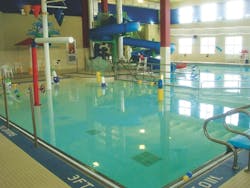About the author: Bob Dickhudt is property manager for the Mankato YMCA. For more information, contact Evan Rapp at [email protected].
All it took was one member of the Mankato YMCA in Mankato, Minn., to positively alter the swimming environment for the 10,000 members who use the club regularly. That member, a professor at Mankato State University, had read about the use of Sphagnum moss to treat and condition the water in public pools in St. Paul, Minn., and talked to YMCA CEO John Kind about it.
Kind made a call to Creative Water Solutions, which developed an all-natural water conditioning system using the moss with its products PoolNaturally and SpaNaturally. He then paid a visit to St. Paul indoor water park Great River, and saw firsthand that the moss had changed not only the quality and clarity of the water, but also created measurable positive impacts on swimmers, spa users, maintenance staff and mechanical equipment.
The moss-based application was installed at the Mankato YMCA's pools — which include an 80,000-gal, four-lane lap pool, a 70,000-gal leisure pool and a 1,500-gal spa — over Memorial Day weekend in 2009. Positive results were seen in the first 24 hours. According to the facility's staff, the moss has transformed the whole "Y" water experience — swimmers' skin, hair and swimsuits do not smell from chlorine after using the pool or spa anymore, and their skin does not feel itchy.
After three years of moss usage, the water quality remains excellent.
Biofilm Basics
In lab studies, Sphagnum moss appears to inhibit the formation of biofilm. Slime on rocks in lakes, tartar on teeth and foam in spas — all of those things and more are caused by biofilm, which is nature's way of providing bacteria in moist or water-filled areas with a suitable environment in which to proliferate, communicate and survive, especially in harsh environments. Only within the past decade have scientists and researchers gained a better understanding of how bacteria live, communicate and grow in water environments.
According to Vance Fiegel, microbiologist and chief scientific officer for Creative Water Solutions, up to 80% of water management issues are attributable to contamination by biofilm. "It’s not yet well known, but chlorine and other chemicals used to kill bacteria are actually absorbed by biofilm, rendering those chemicals ineffective, especially in the pipe, liners and other pool and spa areas," he said.
Biofilm's unique protective coating is made up of complex sugar molecules. These molecules provide a backbone for the additional accumulation of proteins, DNA, calcium and other inorganic materials and substances that flow over the bacteria’s protective shield and become incorporated into the biofilm mass.
Contrary to common belief, bacteria gravitate to the inside surfaces of pipe and the liners of pools and spas, rather than remain suspended in the water. More than 99% of all bacteria in a water system may live within biofilm. Once the bacteria adhere to the surface, they begin the process of colonization and biofilm formation. The biofilm maintains the moist environment, captures and holds nutrients, and provides protection from toxins, such as chlorine and bromine.
Only when bacteria are released from biofilm's protective shield are they vulnerable to chemicals and sanitizers such as chlorine and bromine. But research at Montana State University's Center for Biofilm Research and other research centers, including Creative Water Solutions, has confirmed that as few as 1% of the bacteria stay in suspension. Bacteria actually migrate to a surface and quickly attach themselves.
Improved Swimmer Experience
The implementation of the Sphagnum moss treatment system has created many benefits for Mankato YMCA members. For example, swimmer and lifeguards are no longer exposed to chlorine when they are in the pool areas. The benefits also extend to the maintenance staff and areas of the facility that members rarely see, such as the filter rooms — according to facility staff, these rooms no longer smell like chlorine, and staff are able to stay in the rooms longer while performing maintenance tasks.
According to Creative Water Solutions, the moss provides a significant reduction in "that smell," because it is an effective agent in reducing the production of disinfection byproducts (DBPs) in pools. After a 33-week study in 2011 of two large, commercial indoor swimming pools in the Minneapolis-St. Paul area, the company measured the levels of DBPs and volatile organic compounds (VOCs). The test found that the sphagnum moss treatment reduced DBP and VOC levels and odors.
DBPs are created in pool systems through the chemical reaction of chlorine disinfectant with organic matter. Many DBPs are toxic compounds, such as trihalomethanes and halocetic acids, and are a primary source of the odor and health issues associated with pool facilities and use.
The moss treatment system created additional benefits in regard to pool maintenance. The pool no longer needs to be drained for cleaning, and does not require acid washing, saving money and time. The facility’s HVAC system now experiences less corrosion, resulting in fewer mechanical issues.
Today, the Mankato Y has become a showcase for what a modern recreational and fitness center can be in the 21st century, with other pool operators from nearby colleges and other YMCAs visiting to learn more about the moss application.
Download: Here
